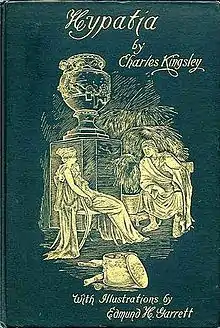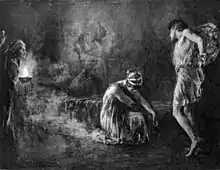Hypatia (novel)
Hypatia, or New Foes with an Old Face is an 1853 novel by the English writer Charles Kingsley. It is a fictionalised account of the life of the philosopher Hypatia, and tells the story of a young monk called Philammon who travels to Alexandria, where he becomes mixed up in the political and religious battles of the day. Intended as Christian apologia, it reflects typical 19th-century religious sentiments of the day. For many years the book was considered one of Kingsley's best novels and was widely read.
 1897 edition illustrated by Edmund H. Garrett | |
| Author | Charles Kingsley |
|---|---|
| Country | United Kingdom |
| Language | English |
Publication date | 1853 |
Plot
The plot revolves around Hypatia the pagan philosopher; Cyril the Christian patriarch; Orestes the power-hungry prefect of Egypt; and Philammon an Egyptian monk.[1] Philammon travels from his monastic community in the desert to Alexandria,[2] and expresses a desire to attend Hypatia's lectures despite Cyril's dislike of Hypatia.[1] Although Hypatia has a deep-seated hatred of Christianity, Philammon becomes her devoted friend and disciple.[1] Philammon also encounters Pelagia, his long-lost sister, a former singer and dancer who is now married to a Gothic warrior.[2] Philammon naturally desires to convert both women to Christianity.[2] The plot is played out against the backdrop of Orestes' scheming to become emperor of Egypt and Africa; he uses Hypatia as a pawn.[1] A subplot involves Raphael Aben-Ezra, a wealthy Jewish associate of Hypatia who falls in love with a Christian girl called Victoria and converts to win her love.[2] A series of events, some of which are orchestrated by a Jewish woman called Miriam, raise tensions between the prefect and the church. Hypatia undergoes a spiritual crisis and comes close to being converted to Christianity by Raphael. Before this can happen, however, rumours are spread that Hypatia is the cause of unrest in the city and she is murdered by a Christian mob. Philammon, despondent, returns to the desert where he eventually becomes abbot of his monastery, albeit with a more worldly view of Christianity.[3]
Themes
Hypatia has a strong anti-Catholic tone which reflects Kingsley's own dislike of priests and monks.[1] Kingsley's portrayal of a fractious and corrupt early Church represented by Cyril and the clergy is intended to reflect the 19th-century Catholic church.[2] Kingsley also disliked priestly celibacy, and makes it clear that, in his view, it damages those who practise it.[3] He was, nevertheless, keen to assert the moral superiority of Christianity over Judaism: of the two Jewish characters in the novel, one – Miriam – is consistently malevolent, and the other – Raphael – abandons his home to become a disillusioned wandering Jew before converting to Christianity. The portrayal of Greco-Roman paganism in the novel is likewise negative: thus when Orestes attempts a pagan revival in Alexandria, he does so by restoring the spectacle and butchery of the gladiatorial arena. Kingsley also devotes parts of the novel to expounding Neoplatonism and explaining its apparent flaws.[3]
Kingsley expresses a view of the superiority of northern Europeans in his portrayal of the Goths in Alexandria as saviours of Christianity, who, although crude and violent, possess the necessary Teutonic values of hardiness and virility to counter the corrupt church.[2][3] This reflects a theme which Kingsley would later expound in a book and lecture series entitled The Roman and the Teuton.[4]
A further theme is the way Kingsley links religious insight with eroticism, a theme which is most overtly displayed in the climax of the novel with Hypatia stripped naked, being torn apart by monks under an enormous image of Christ.[5]
Publication

Hypatia was originally serialised in 1852 in Fraser's Magazine from January 1852 to April 1853, and it was then published in book form in 1853.[6] The book was translated into several European languages, and it was very successful in Germany.[7]
There have been several illustrated editions of the novel, including one with copious illustrations by William Martin Johnson;[8] a second with seventeen illustrations by Edmund H. Garrett;[9] a third with twelve illustrations by Lee Woodward Zeigler;[10] and a fourth with eight illustrations by Byam Shaw.[11] A German edition had illustrations by Rudolf Trache,[12] and an early Spanish edition had seven illustrations by Ramón Alabern and other artists.[13]
Reaction
For many years Hypatia was regarded as Kingsley's "most widely known and appreciated" novel,[7] with interest only dipping in later generations.[6] The book was said to have been Queen Victoria's favourite novel by Kingsley.[14]

The novel notably inspired the painting Hypatia by Charles William Mitchell (1885, Laing Art Gallery, Newcastle) which depicts Hypatia, naked, cowering against an altar, facing her (unseen) murderers.[15] Another painting inspired by the novel was Arthur Hacker's Pelagia and Philammon (1887, Walker Art Gallery, Liverpool) which depicts a naked Pelagia dying, watched by a cloaked, hooded Philammon.[16]
In Kingsley's era criticism of the novel was directed at his negative portrayal of the church in Alexandria and of Cyril in particular. It was this aspect of the novel, as well as its alleged indecency, which thwarted an attempt to bestow an honorary degree at Oxford University on Kingsley in 1863.[6] In addition, some readers were disappointed that Kingsley did not go further in villainising all creeds other than Christianity.[6] The anti-Catholic theme of the novel naturally drew criticism from Catholic churchmen, and among the literary responses were novels by Cardinal Nicholas Wiseman, Fabiola (1854), and John Henry Newman, Callista (1855).[17]
In the modern era criticism of the novel has focused on its anti-Semitism as well as its racial prejudice. The book has been described as "ferociously racist".[18] One review describes it as "Christian apologia, [with] religious and ethnic bigotry in the form of anti-Semitism and anti-Catholicism", but nevertheless concludes that "it is an unexpectedly involving novel, and is well worth searching out."[3] Another review criticises the novel for being "difficult to follow with the myriad of unnecessary characters and their convoluted esoteric arguments", but concludes that "Hypatia stands as an excellent example of fiction written for a specific purpose, as well as an impeccably researched novel that remains true to history."[6]
Adaptations

In 1859 a play based on the novel entitled The Black Agate, or, Old foes with new faces was performed at the Academy of Music in Philadelphia.[19] The play was written by Elizabeth Bowers, who also played the part of Hypatia.[19][20]
A more notable adaptation of the novel to the stage was G. Stuart Ogilvie's Hypatia, which opened at the Haymarket Theatre in London on 2 January 1893. It was produced by Herbert Beerbohm Tree. Julia Neilson played the character of Hypatia, and her husband Fred Terry played Philammon. The play featured an elaborate musical score written by the composer Hubert Parry.[21][22] Ogilvie's play introduced a scheming Jewish character called Issachar (played by Tree) in place of Kingsley's Miriam. The portrayal of Issachar was relatively sympathetic, as Tree had great respect for the Jewish contribution to contemporary theatre.[23] Even The Jewish Chronicle noted that Issachar is "ambitious and able, he plots and counterplots but there is no suspicion or meanness in his nature" and concluded that he was the "least conventional and least offensive of recent stage Jews".[23]
References
- Maria Dzielska, (1995), Hypatia of Alexandria, pages 8–11. Harvard University Press. ISBN 0674437764
- Simon Goldhill, (2011), Victorian Culture and Classical Antiquity, pages 203–5. Princeton University Press. ISBN 0691149844
- Jess Nevins, (2005), The encyclopedia of fantastic victoriana, page 7. MonkeyBrain Books. ISBN 1932265155
- The Roman and the Teuton by Charles Kingsley at Project Gutenberg
- Patrick Brantlinger, William Thesing, (2008), A Companion to the Victorian Novel, page 253 John Wiley & Sons
- Mary Virginia Brackett, Victoria Gaydosik, (2006), Companion to the British Novel, 18th and 19th Centuries, page 216
- Catalogue of an exhibition of one hundred famous first editions in English and French Literature from 1 to 14 December 1909. Ernest Dressel North
- Charles Kingsley, Hypatia; or, New Foes with an Old Face. Illustrated from Drawings by William Martin Johnson. 2 vols. 1894
- Charles Kingsley, Hypatia. With seventeen illustrations by Edmund H. Garrett. 1897
- Charles Kingsley, Hypatia. De luxe limited edition. New York, Taylor, 1899
- Charles Kingsley, Hypatia. With 8 Illustrations by Byam Shaw. 1914
- Hypatia – Christliche Erzählung aus dem fünften Jahrhundert. Mit zahlreichen Bildern von R. Trache.
- Hipatia, ó, Los últimos esfuerzos del paganismo en Alejandría: novela histórica del siglo V. 1857.
- David Anthony Downes, (1972), The Temper of Victorian Belief: Studies in the Religious Novels of Pater, Kingsley and Newman, page 65. Ardent
- Michael A. B. Deakin, (2007), Hypatia of Alexandria: mathematician and martyr, page 163. Prometheus Books
- Jeffrey Richards, (2009), The ancient world on the Victorian and Edwardian stage, page 171. Palgrave Macmillan
- Philip Davis, (2004), The Victorians: 1830–1880, page 293
- Margaret Drabble, (1998), The Oxford companion to English literature, page 465. Oxford University Press
- Catalog Record: The black agate, or, Old foes with new faces, Hathi Trust Digital Library, retrieved 30 January 2013
- Amelia Howe Kritzer (1995) Plays by Early American Women, 1775–1850, page 373. University of Michigan
- Walter Macqueen-Pope, (1948), Haymarket: theatre of perfection, page 337. Allen
- William Archer, (1969), The theatrical 'world' for 1893, page 9. B. Blom
- Nineteenth century theatre: NCT. (1993), Volumes 21–22, page 24. University of London
External links
| Wikisource has original text related to this article: |
| Wikimedia Commons has media related to Hypatia (Charles Kingsley). |
- Hypatia – or New Foes with an Old Face by Charles Kingsley at Project Gutenberg
 Hypatia public domain audiobook at LibriVox
Hypatia public domain audiobook at LibriVox